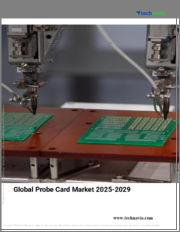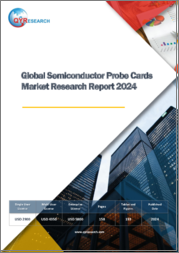
|
시장보고서
상품코드
1605412
프로브 카드 시장 규모, 점유율, 성장 분석, 유형별, 기술별, 용도별, 지역별 - 산업 예측(2024-2031년)Probe Card Market Size, Share, Growth Analysis, By Type (Standard, Advanced Probe Card), By Technology, By Application, By Region - Industry Forecast 2024-2031 |
||||||
프로브 카드 시장 규모는 2022년에 23억 7,375만 달러 되어, 2023년 26억 3,014만 달러에서 2031년까지는 26억 3,056만 달러로 성장하며, 예측 기간(2024-2031년)의 CAGR은 10.8%로 성장할 전망입니다.
프로브 카드 시장은 일렉트로닉스 및 제조업을 중심으로 한 다양한 최종사용자 분야에서 반도체 수요의 급증에 의해 대폭적인 성장이 전망되고 있습니다. 프로브 카드는 전자 테스트 시스템과 반도체 웨이퍼를 연결하는 중요한 매개체로서 제조 공정에서 집적회로의 무결성을 검사하고 검증하는 데 중요한 역할을 합니다. 전자기기의 보급과 함께 집적회로의 고도화가 점점 더 요구됨에 따라 고품질 프로브 카드에 대한 수요는 예측 기간 중 꾸준히 증가할 것으로 예상됩니다. 또한 반도체 제조업체들은 이러한 수요 증가에 대응하기 위해 생산 능력 확장에 적극적으로 투자하고 있으며, 운영을 간소화하기 위해 새로운 시설을 설립하고 있습니다. 이러한 전략적 집중은 생산 효율을 높이는 것뿐만 아니라 반도체 기술의 급속한 발전을 지원하고 제조업체가 시장의 변화하는 요구에 부응할 수 있도록 하는 데 목적이 있습니다. 그 결과, 프로브 카드 산업은 반도체 부문의 광범위한 성장과 일치하는 역동적인 상황을 반영하고 이러한 추세의 혜택을 누릴 수 있는 적절한 위치에 있습니다.
목차
서론
- 조사의 목적
- 조사 범위
- 정의
조사 방법
- 정보 조달
- 2차 데이터와 1차 데이터 방법
- 시장 규모 예측
- 시장의 전제조건과 제한
개요
- 세계 시장 전망
- 공급과 수요의 동향 분석
- 부문별 기회 분석
시장 역학과 전망
- 시장 개요
- 시장 규모
- 시장 역학
- 촉진요인과 기회
- 억제요인과 과제
- Porter의 산업 분석과 영향
- 경쟁 기업 간 경쟁 관계
- 대체품의 위협
- 바이어의 교섭력
- 신규 진출업체의 위협
- 공급 기업의 교섭력
주요 시장 인사이트
- 주요 성공 요인
- 경쟁의 정도
- 주요 투자 기회
- 시장 에코시스템
- 시장의 매력 지수(2023년)
- PESTEL 분석
- 거시경제 지표
- 밸류체인 분석
- 가격 분석
- 기술의 진보
- 규제 상황
- 사례 연구
세계의 프로브 카드 시장 규모 : 유형별·CAGR(2024-2031년)
- 스탠다드 프로브 카드
- 어드밴스트 프로브 카드
세계의 프로브 카드 시장 규모 : 기술별·CAGR(2024-2031년)
- MEMS
- 수직형
- 캔틸레버
- 전문
- 기타 기술
세계의 프로브 카드 시장 규모 : 용도별·CAGR(2024-2031년)
- DRAM
- 플래시
- 파운드리·로직
- 파라메트릭
- 기타 용도
세계의 프로브 카드 시장 규모 : 지역별·CAGR(2024-2031년)
- 북미
- 미국
- 캐나다
- 유럽
- 영국
- 독일
- 스페인
- 프랑스
- 이탈리아
- 기타 유럽 지역
- 아시아태평양
- 중국
- 인도
- 일본
- 한국
- 기타 아시아태평양
- 라틴아메리카
- 브라질
- 기타 라틴아메리카 지역
- 중동 및 아프리카
- GCC 국가
- 남아프리카공화국
- 기타 중동 및 아프리카
경쟁 정보
- 상위 5사의 비교
- 주요 기업의 시장 포지셔닝(2023년)
- 주요 시장 기업이 채택한 전략
- 시장의 최근 동향
- 기업의 시장 점유율 분석(2023년)
- 주요 기업의 기업 개요
- 회사 개요
- 제품 포트폴리오 분석
- 기업의 부문별 점유율 분석
- 매출의 전년대비 비교(2021-2023년)
주요 기업 개요
- General Mills Inc.
- Amway
- Conagra Brands Inc.
- Cargill Incorporate
- Abbott Laboratories
- Kraft Foods Group Inc.
- The Coca-Cola Company
- PepsiCo Inc.
- Atkins Nutritionals Inc.
- Brunswick Corporation
- Nidec Corporation
- Feinmetall
- Advantest
- Japan Electronic Materials Corp.
- Micronics Japan Co., Ltd.
- Technoprobe S.p.A.
- MPI Corporation
- Teseda Corporation
- JEM America Corp.
- Wentworth Laboratories Ltd.
결론과 제안
KSA 24.12.24Probe Card Market size was valued at USD 2373.75 million in 2022 and is poised to grow from USD 2630.14 million in 2023 to USD 2630.56 million by 2031, growing at a CAGR of 10.8% in the forecast period (2024-2031).
The probe card market is poised for substantial growth, driven by the surging demand for semiconductors across various end-user sectors, particularly electronics and manufacturing. As a critical intermediary between electronic test systems and semiconductor wafers, probe cards play an essential role in inspecting and validating the integrity of integrated circuits during the manufacturing process. With the proliferation of electronic devices necessitating increasingly sophisticated integrated circuits, the demand for high-quality probe cards is expected to remain robust throughout the forecast period. Moreover, semiconductor manufacturers are actively investing in the expansion of their production capabilities to accommodate this heightened demand, establishing new facilities to streamline their operations. This strategic focus not only aims to enhance production efficiency but also to support the rapid advancements in semiconductor technology, ensuring that manufacturers can meet the evolving needs of the market. As a result, the probe card industry is well-positioned to benefit from these trends, reflecting a dynamic landscape that aligns with the broader growth of the semiconductor sector.
Top-down and bottom-up approaches were used to estimate and validate the size of the Probe Card market and to estimate the size of various other dependent submarkets. The research methodology used to estimate the market size includes the following details: The key players in the market were identified through secondary research, and their market shares in the respective regions were determined through primary and secondary research. This entire procedure includes the study of the annual and financial reports of the top market players and extensive interviews for key insights from industry leaders such as CEOs, VPs, directors, and marketing executives. All percentage shares split, and breakdowns were determined using secondary sources and verified through Primary sources. All possible parameters that affect the markets covered in this research study have been accounted for, viewed in extensive detail, verified through primary research, and analyzed to get the final quantitative and qualitative data.
Probe Card Market Segmental Analysis
Global Probe Card Market is segmented by Type, by Technology, by Application, and by Region. Based on Type, the market is segmented into Standard Probe Card, Advanced Probe Card. Based on Technology, the market is segmented into MEMS, Vertical, Cantilever, Speciality, Other Technologies. Based on Application, the market is segmented into DRAM, Flash, Foundry and Logic, Parametric, Other Applications. Based on region, the market is segmented into North America, Europe, Asia Pacific, Latin America and Middle East & and Africa.
Driver of the Probe Card Market
The Global Probe Card Market is primarily driven by the increasing demand for electronic testing within the semiconductor industry. While consumer awareness regarding the advantages of probe card solutions remains low, hindering market expansion, strategic partnerships and collaborative efforts among companies present new growth opportunities. Nevertheless, the high cost associated with probe card solutions could restrain market progression. Additionally, the rise of advanced technologies such as autonomous driving, artificial intelligence, 5G, and the Internet of Things is further enhancing semiconductor usage, thus positively impacting the probe card market. Key industry players are engaging in mergers and acquisitions to bolster their competitive edge, with the need for specialized testing equipment growing as semiconductor device manufacturers adapt to component miniaturization.
Restraints in the Probe Card Market
The Probe Card market is facing significant restraints due to the growing demand for intricate electronic circuitry and the rapid technological advancements in consumer electronics. These factors create challenges for market growth, as developing complex probe cards is often a time-consuming and labor-intensive process. Manufacturers must continuously upgrade and enhance their existing facilities to keep pace with evolving technological requirements, which can strain resources and slow production. Consequently, these obstacles may hinder the overall expansion of the Probe Card market, making it difficult for companies to meet the increasing demands of modern electronic applications effectively.
Market Trends of the Probe Card Market
The probe card market is poised for significant growth, driven by the increasing demand for compact and portable electronic devices. As semiconductor OEMs prioritize research and development for micro components, the trend toward electronic component miniaturization necessitates upgrades in manufacturing facilities to accommodate emerging technologies such as MEMS and 3D ICs. Consequently, there is a heightened demand for advanced testing equipment that ensures the reliability and performance of these miniaturized devices. This shift in focus among semiconductor manufacturers underscores the vital role of probe cards, positioning them as essential tools for quality assurance in a rapidly evolving electronics landscape during the forecast period.
Table of Contents
Introduction
- Objectives of the Study
- Scope of the Report
- Definitions
Research Methodology
- Information Procurement
- Secondary & Primary Data Methods
- Market Size Estimation
- Market Assumptions & Limitations
Executive Summary
- Global Market Outlook
- Supply & Demand Trend Analysis
- Segmental Opportunity Analysis
Market Dynamics & Outlook
- Market Overview
- Market Size
- Market Dynamics
- Driver & Opportunities
- Restraints & Challenges
- Porters Analysis & Impact
- Competitive rivalry
- Threat of substitute
- Bargaining power of buyers
- Threat of new entrants
- Bargaining power of suppliers
Key Market Insights
- Key Success Factors
- Degree of Competition
- Top Investment Pockets
- Market Ecosystem
- Market Attractiveness Index, 2023
- PESTEL Analysis
- Macro-Economic Indicators
- Value Chain Analysis
- Pricing Analysis
- Technological Advancement
- Regulatory Landscape
- Case Studies
Global Probe Card Market Size by Type & CAGR (2024-2031)
- Standard Probe Card
- Advanced Probe Card
Global Probe Card Market Size by Technology & CAGR (2024-2031)
- MEMS
- Vertical
- Cantilever
- Speciality
- Other Technologies
Global Probe Card Market Size by Application & CAGR (2024-2031)
- DRAM
- Flash
- Foundry and Logic
- Parametric
- Other Applications.
Global Probe Card Market Size by Region & CAGR (2024-2031)
- North America, (by Type, by Technology, by Application)
- US
- Canada
- Europe, (by Type, by Technology, by Application)
- UK
- Germany
- Spain
- France
- Italy
- Rest of Europe
- Asia-Pacific, (by Type, by Technology, by Application)
- China
- India
- Japan
- South Korea
- Rest of Asia Pacific
- Latin America, (by Type, by Technology, by Application)
- Brazil
- Rest of Latin America
- Middle East & Africa, (by Type, by Technology, by Application)
- GCC Countries
- South Africa
- Rest of Middle East & Africa
Competitive Intelligence
- Top 5 Player Comparison
- Market Positioning of Key Players, 2023
- Strategies Adopted by Key Market Players
- Recent Developments in the Market
- Company Market Share Analysis, 2023
- Company Profiles of All Key Players
- Company Details
- Product Portfolio Analysis
- Company's Segmental Share Analysis
- Revenue Y-O-Y Comparison (2021-2023)
Key Company Profiles
- General Mills Inc.
- Company Overview
- Business Segment Overview
- Financial Updates
- Key Developments
- Amway
- Company Overview
- Business Segment Overview
- Financial Updates
- Key Developments
- Conagra Brands Inc.
- Company Overview
- Business Segment Overview
- Financial Updates
- Key Developments
- Cargill Incorporate
- Company Overview
- Business Segment Overview
- Financial Updates
- Key Developments
- Abbott Laboratories
- Company Overview
- Business Segment Overview
- Financial Updates
- Key Developments
- Kraft Foods Group Inc.
- Company Overview
- Business Segment Overview
- Financial Updates
- Key Developments
- The Coca-Cola Company
- Company Overview
- Business Segment Overview
- Financial Updates
- Key Developments
- PepsiCo Inc.
- Company Overview
- Business Segment Overview
- Financial Updates
- Key Developments
- Atkins Nutritionals Inc.
- Company Overview
- Business Segment Overview
- Financial Updates
- Key Developments
- Brunswick Corporation
- Company Overview
- Business Segment Overview
- Financial Updates
- Key Developments
- Nidec Corporation
- Company Overview
- Business Segment Overview
- Financial Updates
- Key Developments
- Feinmetall
- Company Overview
- Business Segment Overview
- Financial Updates
- Key Developments
- Advantest
- Company Overview
- Business Segment Overview
- Financial Updates
- Key Developments
- Japan Electronic Materials Corp.
- Company Overview
- Business Segment Overview
- Financial Updates
- Key Developments
- Micronics Japan Co., Ltd.
- Company Overview
- Business Segment Overview
- Financial Updates
- Key Developments
- Technoprobe S.p.A.
- Company Overview
- Business Segment Overview
- Financial Updates
- Key Developments
- MPI Corporation
- Company Overview
- Business Segment Overview
- Financial Updates
- Key Developments
- Teseda Corporation
- Company Overview
- Business Segment Overview
- Financial Updates
- Key Developments
- JEM America Corp.
- Company Overview
- Business Segment Overview
- Financial Updates
- Key Developments
- Wentworth Laboratories Ltd.
- Company Overview
- Business Segment Overview
- Financial Updates
- Key Developments



















